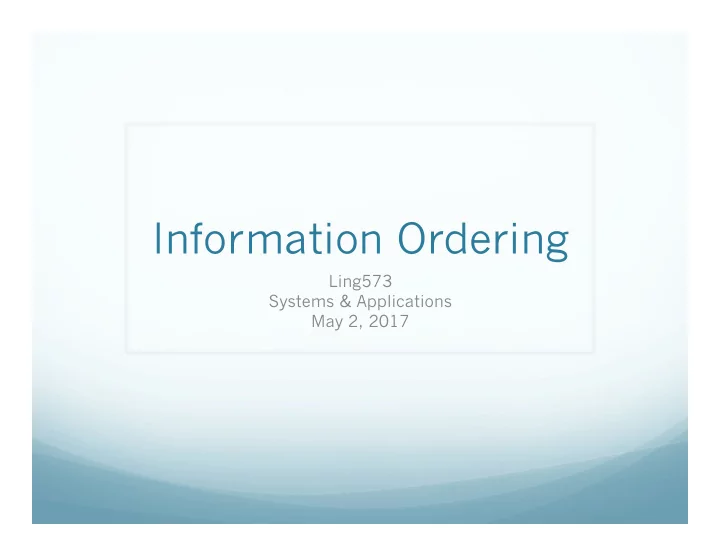

Information Ordering Ling573 Systems & Applications May 2, 2017
Roadmap Information ordering Ensemble of experts Integrating sources of evidence Entity-based cohesion Motivation Defining the entity grid Entity grid for information ordering
Integrating Ordering Preferences Learning Ordering Preferences (Bollegala et al, 2012) Key idea: Information ordering involves multiple influences Can be viewed as soft preferences Combine via multiple experts: Chronology Sequence probability Topicality Precedence/Succession
Basic Framework Combination of experts Build one expert for each of diff’t preferences Take a pair of sentences (a,b) and partial summary Score > 0.5 if prefer a before b Score < 0.5 if prefer b before a Learn weights for linear combination Use greedy algorithm to produce final order
Chronology Expert Implements the simple chronology model If sentences from two different docs w/diff’t times Order by document timestamp If sentences from same document Order by document order Otherwise, no preference
Topicality Expert Same motivation as Barzilay 2002 Example: The earthquake crushed cars, damaged hundreds of houses, and terrified people for hundreds of kilometers around. A major earthquake measuring 7.7 on the Richter scale rocked north Chile Wednesday. Authorities said two women, one aged 88 and the other 54, died when they were crushed under the collapsing walls. 2 > 1 > 3
Topicality Expert Idea: Prefer sentence about the “current” topic Implementation: Prefer sentence with highest similarity to sentence in summary so far Similarity computation: Cosine similarity b/t current & summary sentence Stopwords removed; nouns, verbs lemmatized; binary
Precedence/Succession Experts Idea: Does current sentence look like blocks preceding/ following current summary sentences in their original documents? Implementation: For each summary sentence, compute similarity of current sentence w/most similar pre/post in original doc Similarity?: cosine PREF pre (u,v,Q)= 0.5 if [Q=null] or [pre(u)=pre(v)] 1.0 if [Q!=null] and [pre(u)>pre(v)] 0 otherwise Symmetrically for post
Sketch
Probabilistic Sequence Intuition: Probability of summary is the probability of sequence of sentences in it, assumed Markov P(summary)= Π P(S i |S I-1 ) Issue: Sparsity: will we actually see identical pairs in training? Repeatedly backoff: To N, V pairs in ordered sentences To backoff smoothing + Katz
Results & Weights Trained weighting using a boosting method Combined: Learning approach significantly outperforms random, prob Somewhat better that raw chronology Expert Weight Succession 0.44 Chronology 0.33 Precedence 0.20 Topic 0.016 Prob. Seq. 0.00004
Observations Nice ideas: Combining multiple sources of ordering preference Weight-based integration Issues: Sparseness everywhere Ubiquitous word-level cosine similarity Probabilistic models Score handling
Entity-Centric Cohesion Continuing to talk about same thing(s) lends cohesion to discourse Incorporated variously in discourse models Lexical chains: Link mentions across sentences Fewer lexical chains crossing à shift in topic Salience hierarchies, information structure Subject > Object > Indirect > Oblique > …. Centering model of coreference Combines grammatical role preference with Preference for types of reference/focus transitions
Entity-Based Ordering Idea: Leverage patterns of entity (re)mentions Intuition: Captures local relations b/t sentences, entities Models cohesion of evolving story Pros: Largely delexicalized Less sensitive to domain/topic than other models Can exploit state-of-the-art syntax, coreference tools
Entity Grid Need compact representation of: Mentions, grammatical roles, transitions Across sentences Entity grid model: Rows: sentences Columns: entities Values: grammatical role of mention in sentence Roles: (S)ubject, (O)bject, X (other), __ (no mention) Multiple mentions: Take highest
Grids à Features Intuitions: Some columns dense: focus of text (e.g. MS) Likely to take certain roles: e.g. S, O Others sparse: likely other roles (x) Local transitions reflect structure, topic shifts Local entity transitions: {s,o,x,_} n Continuous column subsequences (role n-grams?) Compute probability of sequence over grid: # occurrences of that type/# of occurrences of that len
Vector Representation Document vector: Length: # of transition types Values: Probabilities of each transition type Can vary by transition types: E.g. most frequent; all transitions of some length, etc
Recommend
More recommend